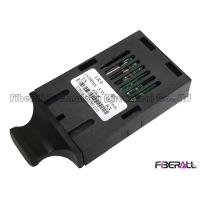FA-TCSGPS49-20D,Single Mode GPON OLT SFP Fiber Optic Transceiver Class B+ Bi-directional SC 20KM
The optical fiber transceiver is transmitted on fiber optic cable
through one pairs of OXA of optical transceiver, namely optical
fiber transmitter (TOXA) and optical fiber receiver (ROXA).
TOSA has the largest transmitting power in the design, and ROXA
also has a certain range of optical signal sensitivity in design.
Especially, the signal receiving range of ROXA is certain, if the
signal is too small, it will be hard to be detected and if it is
too high, it will lead to the ROXA light saturation, and the device
is lossless. Because LX, ZX, XD optical fiber transceivers are
designed for long distance optical fiber transmission, so the
transmitter power is much higher than the multi-mode optical
transceiver, especially XD, ZX, EX is more prominent. Therefore,
the connection test of single-mode optical fiber transceiver is
different from multi-mode optical module. When single mode fiber
modules are used for close distance (local) testing, the amplifier
must be sufficiently large enough to ensure correct completion.
When do not use attenuator during test, unless receiving power
design of optical transceiver is with receiving sensitivity
automatic regulating function ,if not, there may be receiving light
saturation or critical saturation phenomenon. When the receiver
come across light saturation, the outer link of the optical fiber
link will show the case that the connection is blocked; and in the
case of the critical saturation of the optical receiver, the
situation of the gross packet in the data transmission will appear.
The above two situations often make the user mistakenly think of
failure of the optical fiber transceiver, and these two situations
are also applicable to the actual optical cable and fiber optic
accessories, insertion attenuation is too small in the use of
optical fiber, resulting in receiving optical signal exceeds the
scope of ROXA receiving range.
Without considering dispersion, the allowable transmission distance
of the Gigabit fiber transceiver can be obtained by the following
formula: Transmission distance (TOSA = minimum transmitted power
-ROSA minimum received power) / (0.25 to 0.35 dbm), which is 0.25
to 0.35dbm insertion loss of per kilometer fiber cable, and also
depends on the quality optical cable.
Another direct calculation method of transmission distance: Module
transmission distance = (TOSA minimum transmitted power -ROSA
minimum received power) absolute value - optical fiber insertion
attenuation (DBM). When choosing a suitable fiber optical
transceiver, the maximum receiving power of the receiving signal
with the maximum receiving power of not exceeding ROSA must be
considered.
If the test site can not find the optical attenuator, a simple
method is to pull out a little of the fiber jumper (SC/LC/ST/FC)
which is inserted into the optical transceiver, until the indicator
of the device link port just lit and don't burn out, then we can
confirm the optical signal received by the ROXA is in the design
scope.
Main Parameters Of SFP Fiber Optic Transceiver
| Part number | FA-TCSGPS49-20D |
| Data rate | downstream 2488Mbps upstream1244Mbps |
| Fiber Interface | Single fiber SC/UPC |
| Compatible fiber | Single mode fiber 9/125um |
| Working Wavelength | 1490TX/1310RX |
| Transmitting distance | Up to 20KM |
| Power supply | +3.3V |
| Temperature | 0°C to +70°C |
Main Characteristics Of GPON Optical Transceiver
1, SFP package with SC/UPC fiber Connector;
2, 1490nm DFB laser transmitter and 1310nm burst-mode APD-TIA
receiver;
3, Single fiber bi-directional,downstream 2488Mbps/upstream1244Mbps
application;
4, Reset burst-mode receiver design support more than 15dB dynamic
range;
5, Operating case temperature 0 to 70°C;
6, Single 3.3V power supply;
7, DDM is compliant with SFF-8472;
8, Digital burst RSSI function to monitor the input optical power
level;
9, LVPECL compatible data input/output interface;
10, LVTTL TX DISABLE control;
11, LVTTL TX FAULT signal;
12, LVTTL receiver Signal Detect (SD) indication;
13, Low EMI and excellent ESD protection;
14, Compliant with Class I laser safety standard IEC-60825;
15, Meets RoHS-6 requirements.










